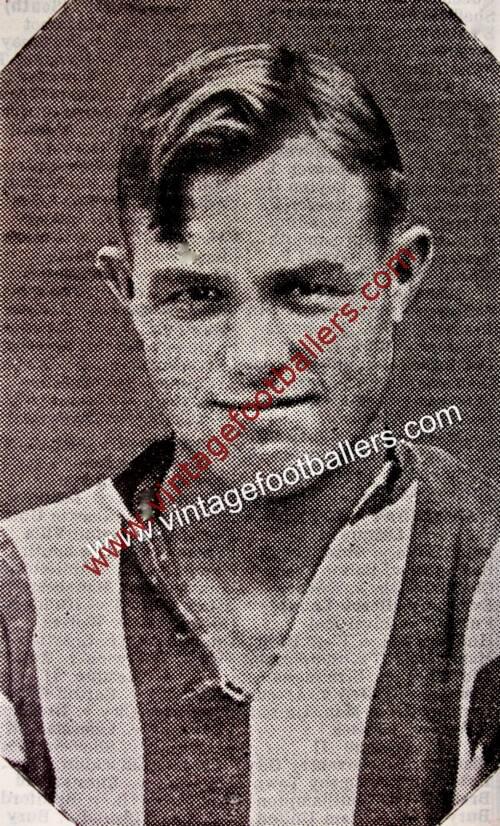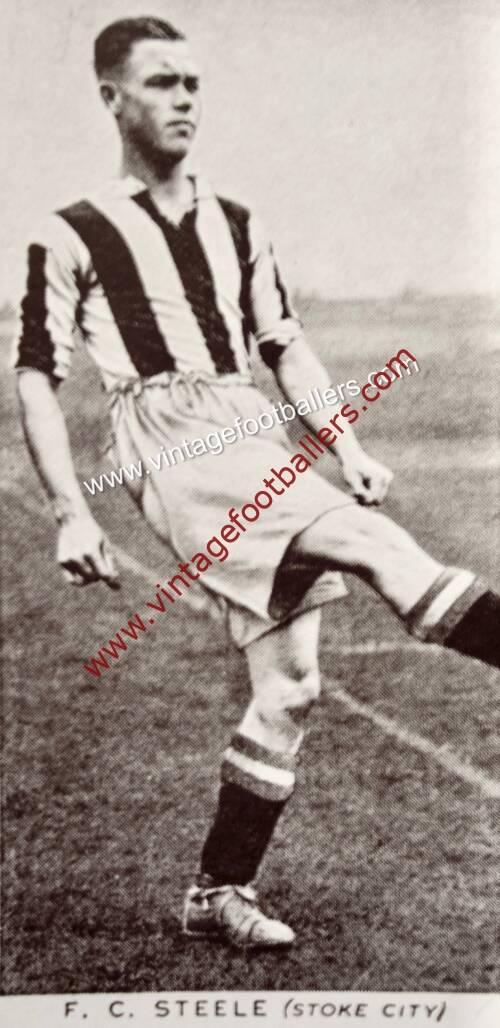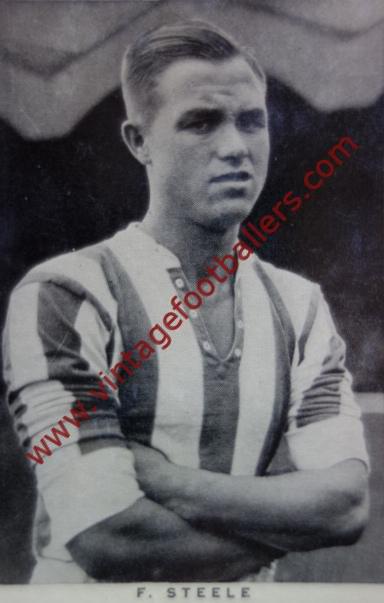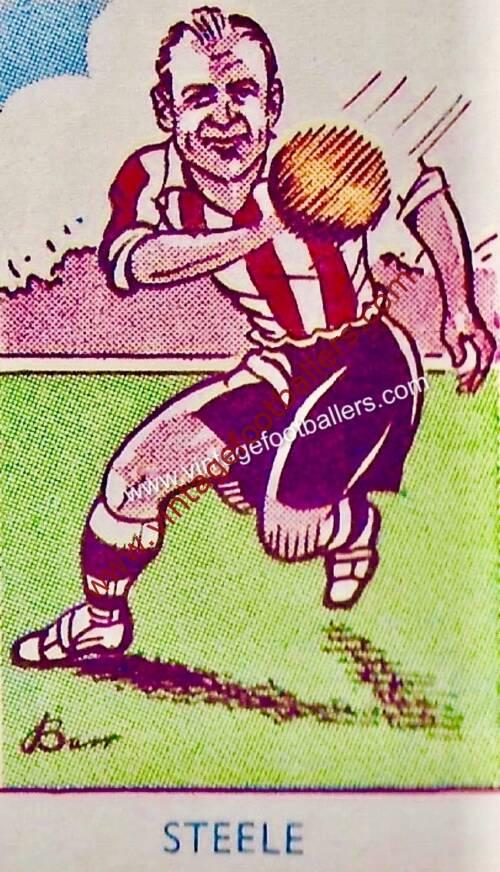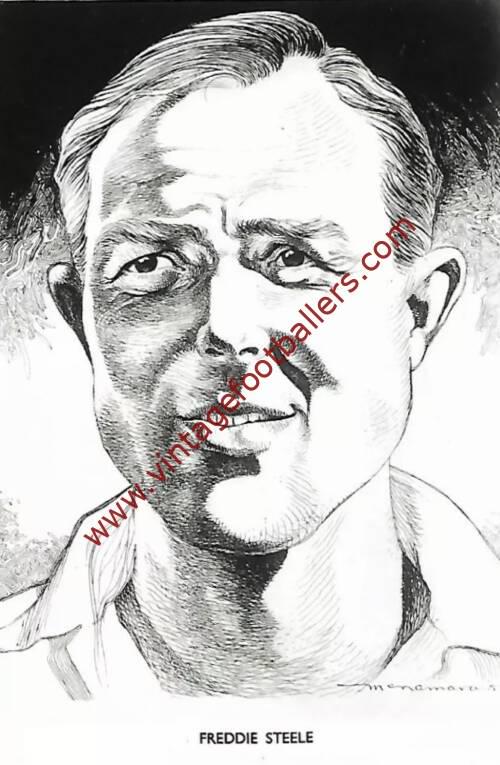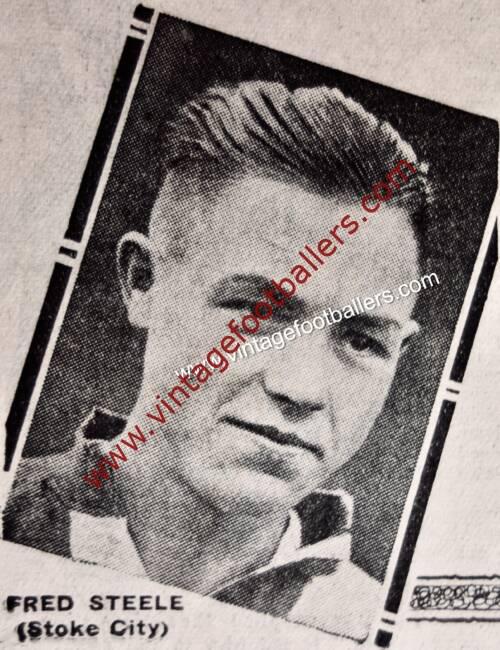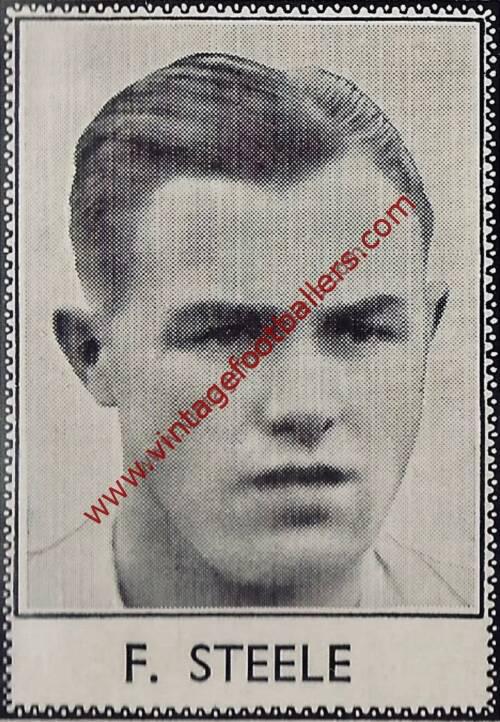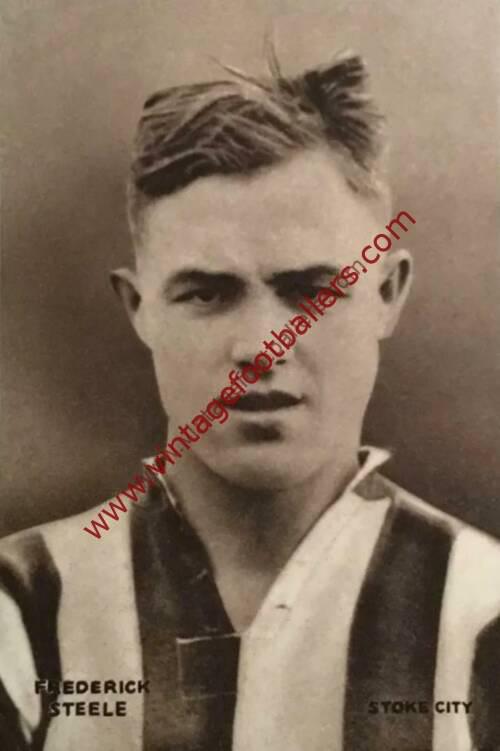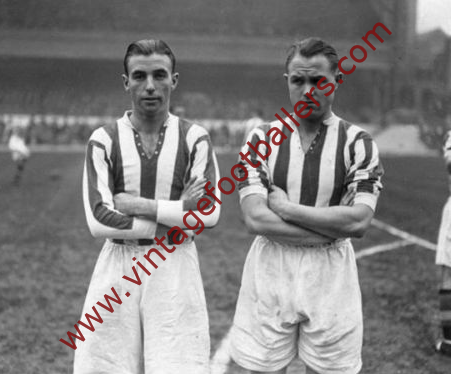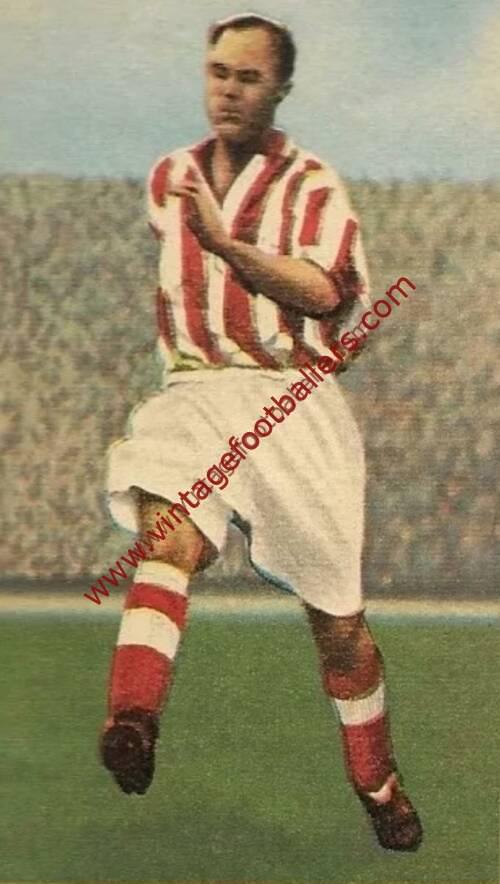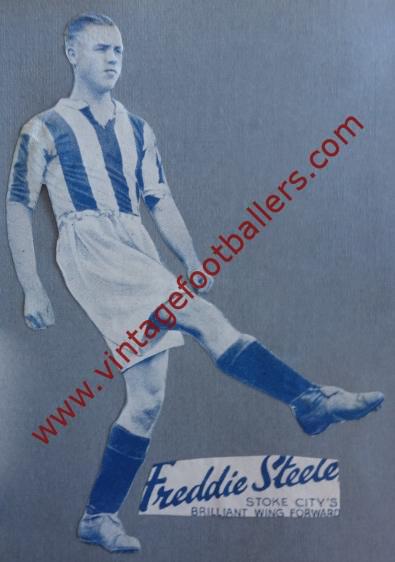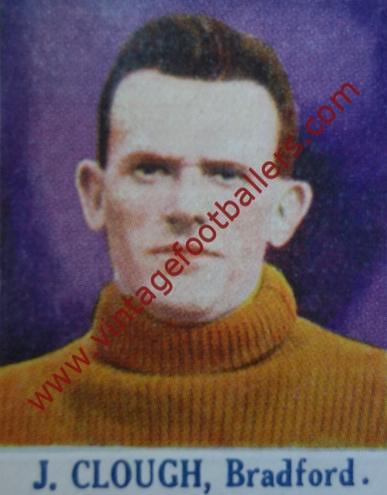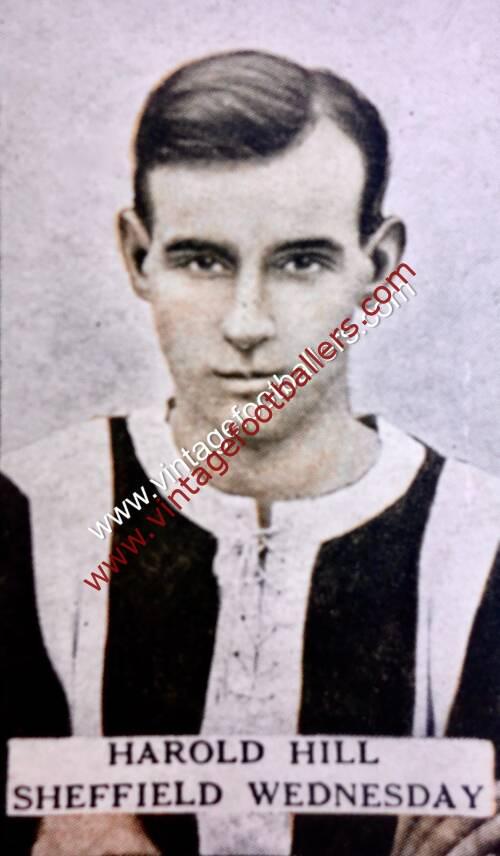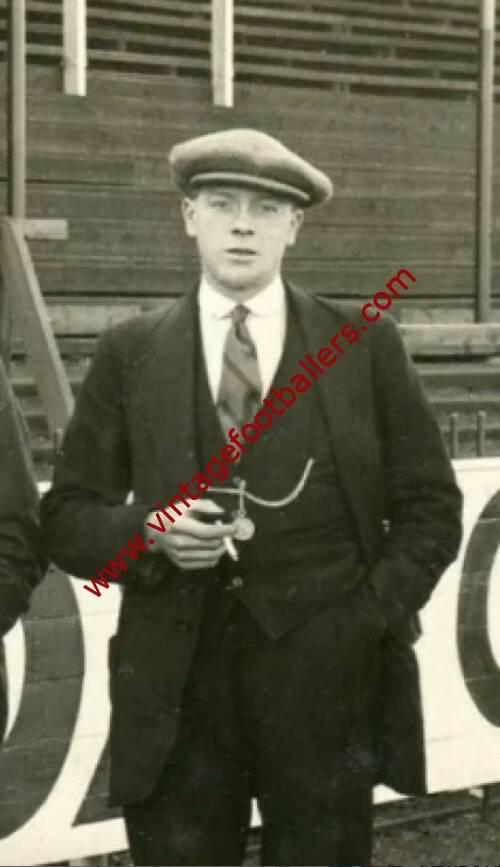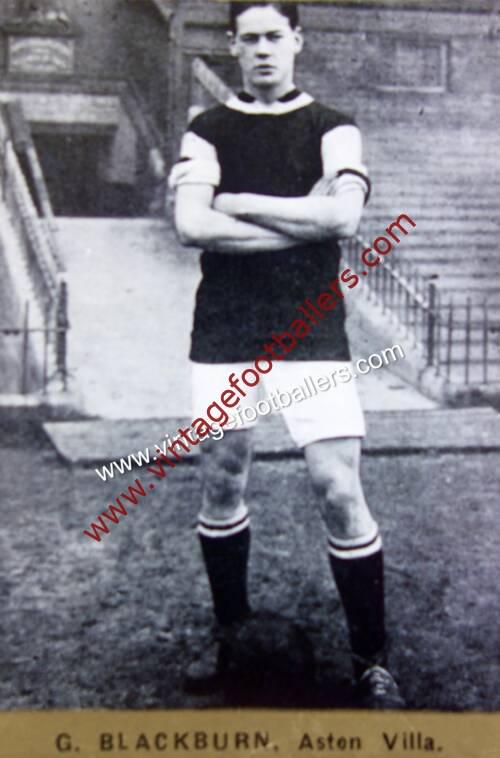Please choose your photo size from the drop down menu below.
If you wish your photo to be framed please select Yes.
Note: 16″x 20″not available in a frame.
Images can also be added to accessories. To order please follow these links
£8.95 – £49.95
In stock
Please choose your photo size from the drop down menu below.
If you wish your photo to be framed please select Yes.
Note: 16″x 20″not available in a frame.
Images can also be added to accessories. To order please follow these links
Hanley, Stoke-on-Trent, Staffordshire born centre forward Freddie Steele played junior football for Downings Tileries and was on the books of Stoke City from the age of fifteen, signing for them as an amateur in the summer of 1931, turning professional in August 1933. Steele made his Football League debut at Huddersfield Town in December 1934 and helped them to a fourth place finish in the League Championship in 1935-36, still Stoke’s highest ever League placing. He set a club record when he scored 33 League goals in the 1936-37 season, a haul which included 5 goals in a 10-3 demolition of West Bromwich Albion in February 1937 and hat-tricks against Birmingham (home and away), Middlesbrough, Sunderland and Brentford, and is still a club record for an individual season.
He was first selected to play for England in October 1936 in a 2-1 defeat to Wales at Ninian Park, scoring at Hampden Park in a 3-1 defeat to Scotland the following April. During the season his 214-day-long international career also made for impressive reading, as he hit eight goals in a total of six games for England, including a first half hat-trick in Sweden and braces against Norway and Finland in England’s May 1937 summer tour to Scandinavia. He also represented The Football League, playing in a 1-0 defeat to The Scottish League at Ibrox Park in September 1937.
Nicknamed “Nobby” by the fans, Steele was noted for his brilliant heading ability. He had a strong physique, and was able to battle with defenders willing to get physical with him. He was able to play with both feet, and had a good turn of pace. Stanley Matthews said of him: “In the penalty box he was lethal, clinical and merciless, firing in shots from the tightest of angles and the smallest of spaces … a masterpiece of strength, endurance, polish and skill that more often than not resulted in a billowing net.”
He continued to terrorise The Baggies in 1937-38, scoring a hat-trick in a 4-0 home win on 6th September, before getting five goals in an 8-1 trouncing of Derby County five days later. He finished the 1937-38 campaign with 15 goals in 23 games, having struggled to recover from a knee injury sustained in a game against Charlton Athletic. Steele then returned to form in 1938-39, scoring 27 goals in 33 matches, including four against Birmingham and a hat-trick against Chelsea.
However a series of misfortunes severely disrupted his playing career. Besides picking up the serious knee injury in 1937, he retired two years later aged just 23 after suffering from depression. After an improvement in his physical and mental state he resumed his career, only to have it cut short again, this time due to the outbreak of the Second World War. Guesting for several clubs including Sheffield United, Northampton Town, Notts County, Leicester City, Doncaster Rovers, Bradford Park Avenue, Leeds United, Nottingham Forest and Fulham, he also had a spell in Iceland where he coached KR Reykjavík and was appointed manager of the Icelandic national team for their first ever international match against Denmark on 17th July 1946.
He returned to the Potteries in 1945-46, scoring 49 goals in 43 games during the course of the season. Competitive football resumed for the 1946-47 season, and Steele scored 31 goals in 43 games, bagging hat-tricks against Middlesbrough, Sheffield United, Grimsby Town, and Burnley, as Stoke posted another fourth-place finish to equal the club record when seemingly well placed to win the League coming into the home straight. He was Stoke’s top scorer for a sixth successive season in 1947-48, though he hit just 12 goals in 23 appearances; his contribution as the campaign was limited as he spent four months on the sidelines with a broken leg. He hit 19 goals in 42 games in 1948-49, though Frank Bowyer had by then taken up the mantle as Stoke’s main goal getter. Steele left the club in 1949, due to persistent knee problems joining Mansfield Town for £1,000 as player-manager in June 1949. He scored 159 goals in 251 appearances and remains the second highest goalscorer in the club’s history, after John Ritchie. His total in all competitions is 220 goals in 384 appearances.
At Mansfield he was prolific in front of goal, scoring 43 goals in 61 League and Cup appearances – this scoring record made his job as manager much easier. The Stags finished eighth in the Third Division (North) in 1949-50. They then went on a 23 game unbeaten run, but could only end up finishing as the division’s runners-up in 1950-51, missing out on promotion seven points behind Champions Rotherham United. Steele left Field Mill to become the manager of Port Vale for a another four-figure fee in December 1951, and Mansfield finished the 1951-52 season in sixth place under his successor George Jobey.
For two seasons he combined management with increasingly occasional appearances, scoring 12 goals for Vale in 25 appearances. His six years with the club were some of the most significant in the club’s history, as, after finishing as runners up in 1952-53, he masterminded a Third Division (North) Championship winning season in 1953-54, as well leading the club to their only ever FA Cup semi final appearance where they lost 2-1 to eventual winners West Bromwich Albion at Villa Park. After the team he cultivated proved to be ‘past it’ by the start of 1957, he too left the club that January. Returning as manager in October 1962, his second spell would prove less successful and he left the club for good three years later in February 1965. He remains a legendary figure in the histories of both Stoke City and Port Vale.
His nephew is former Northamptonshire, Derbyshire and England cricketer David Steele.
| Weight | N/A |
|---|
